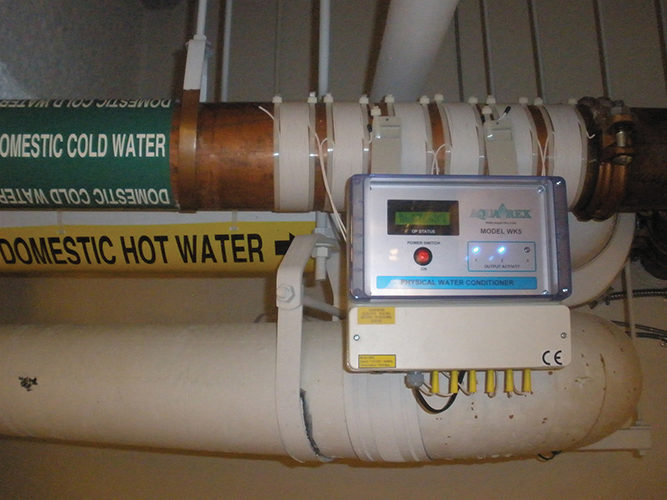No Scaling at the Cosmopolitan
Aqua-Rex technology solved the Las Vegas resort’s hard water issues and is still going strong after more than a decade.

The Cosmopolitan of Las Vegas (the Cosmo) opened in December 2010. Aqua-Rex was called in shortly after the opening to look at ways of solving the hard water issues that the hotel engineer expected to occur from the 20-grain hardness in the domestic water supply from nearby Lake Mead.
Now, 13 years after completing the installation, the Cosmo engineering team reports that there have been no issues with scaling anywhere on the property — a sharp contrast with experience on neighboring properties where frozen valves, scaled-up showerheads and failing heaters are the norm.
Scaling of shut-off valves is a perennial problem in Las Vegas resorts, as shown by this typical valve from a major property not far from the Cosmo (Figure 1). No such issues have occurred over the 13 years since the Cosmo opened, as the picture of a comparable valve shows (Figure 2). Likewise, the plate-and-frame heat exchangers have performed perfectly well without disassembling them for cleaning.
 |  |
The resort rooms include black countertops; none show the typical calcium scaling that occurs even in properties with conventional water softeners. Compare the picture of a countertop (Figure 3) in the Cosmo with the picture of one in a nearby five-star resort with water softeners on the hot water services (Figure 4).
 |  |
Scale on countertops and showerheads comes mainly from the cold water services, so only treating the hot water will still allow scale buildup in these places.
Aqua-Rex is an electronic, physical water conditioner that generates radio waves in the water by aerials wrapped externally around the piping. These radio waves travel upstream and downstream in the water throughout the pipework, acting on the iron molecules to create nucleation seeds onto which the scale forms in preference to the surfaces.
Instead of sticking to showerheads, countertops and heat exchangers, the scale is like loose chalk dust in the water and doesn’t cause problems normally seen in hard water. These devices have been performance-tested and verified by IAPMO R & T Labs using the test protocol IGC 335.
Booster pumps and circulation pumps act as a barrier to effectively transmitting these radio waves, so in larger applications such as the Cosmo, it is necessary to treat each pressure zone as a separate entity.
At the Cosmo, there are 11 pressure zones, each with triple-plate heat exchangers drawing makeup water from a common 6-inch boosted cold water supply that then provides the cold water services as well. Both this line and the 1 1/2-inch hot water return are treated with an Aqua-Rex unit (Figures 5 and 6).
 |  |
In the resort’s two towers, there are multiple recirculation loops with electric booster heaters treated with 2-inch Aqua-Rex units. The restrooms in the low-rise casino and restaurant areas also have dedicated returns with electric water heaters, treated with 1-inch Aqua-Rex units.
Altogether, nearly 50 units are on the property, but the installed cost was less than $100,000. What is significant is that no maintenance or servicing has been required over the 10 years they have been operating, and the electricity consumption over that period would be around $10,000 in total.
The costs of installing and maintaining conventional softeners over this period would have been millions of dollars. In addition to the savings made on capital costs, salt for regeneration, labor and media replacement, significant water savings occurred.
For every two grains of hardness treated by a conventional softener, the water consumption is increased by 1%. An extra 10% of water would have been consumed by the Cosmo if conventional softening equipment had been installed.
Softener technology has not moved forward much since the ion exchange process was first invented. Technologies in the electronics sector have changed over the same period, so why should the treatment of hard water be an exception? The cost, space and maintenance savings offered by technologies such as Aqua-Rex bring with them the environmental benefit of not poisoning water sources with chloride-rich effluent from conventional softeners.
The long-sought-after third-party performance verification is now available under the IAPMO R & T Labs IGC 335 Rapid Scaling Test protocol, so why persist with old, expensive, inefficient and environmentally damaging technology?
Jonny Seccombe studied geography and geology at Oxford University and has worked in the water treatment industry investigating the performance of physical water conditioners over the last 27 years. He is president and owner of Aqua-Rex LLC, the U.S. distributor of Aqua-Rex softener alternatives. He is an ASPE-certified CPD provider on the subject of physical water conditioners.




